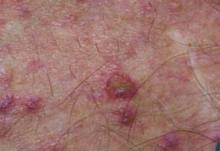User login
A72-year-old male with a history of renal transplantation underwent laparoscopic cholecystectomy for cholelithiasis. On post-operative day one, he developed worsening abdominal pain. An urgent exploratory laparotomy revealed no abnormalities. Over the next few days, he experienced worsening confusion and agitation. He developed respiratory failure, as well as a cutaneous eruption over the face, chest, abdomen, back, and upper extremities.
What is the most sensitive test for diagnosis of this eruption?
- Tzanck smear;
- Darkfield microscopy;
- Direct fluorescent antibody testing;
- Polymerase chain reaction; or
- Viral culture.
Discussion
The answer is D: polymerase chain reaction. Varicella zoster virus (VZV) was detected by rapid polymerase chain reaction from a skin biopsy specimen and from a sample of cerebrospinal fluid. It was also detected by viral culture from tracheal secretions. The patient was diagnosed with disseminated herpes zoster with VZV encephalitis and pneumonitis. He was treated with intravenous acyclovir, 1 g every eight hours for 14 days. His respiratory function and mental status gradually improved.
Herpes zoster is a painful vesicular eruption confined to the distribution of a sensory dermatome. It is caused by the reactivation of latent VZV located in the dorsal root ganglion of the affected dermatome. Triggers for reactivation include stress, trauma, fever, radiation therapy, and immunosuppression. The reactivation of VZV can also present in a disseminated fashion. Herpes zoster is classified as disseminated when more than 20 vesicular lesions occur outside of the primary and adjacent dermatomes.1 Disseminated herpes zoster can occur in immunocompetent patients, but it usually occurs in the setting of immunosuppression.2 It is seen most often in the settings of HIV, malignancy, and immunosuppressive therapy.1
The cutaneous lesions of herpes zoster begin as erythematous macules and papules that progress to vesicles. The vesicular lesions can evolve into pustules. The vesicles become crusts after seven to 10 days. Intense pain often precedes the cutaneous eruption, which can lead to misdiagnosis as myocardial infarction, pleurisy, acute surgical abdomen, or herniated intervertebral disk.2
Disseminated herpes zoster can also involve the central nervous system, lungs, liver, heart, and gastrointestinal tract. Pulmonary involvement is the most common of the possible visceral manifestations. Visceral zoster occurs in 10% of immunocompromised patients with cutaneous zoster.1
The differential diagnosis of disseminated herpes zoster includes bullous impetigo, insect bites, erythema multiforme, papular urticaria, drug eruption, contact dermatitis, and other viral exanthems such as coxsackie virus, rickettsial pox, and smallpox. The best initial test is a Tzanck smear of a scraping from the base of a lesion. The presence of multinucleated giant cells and epithelial cells with acidophilic intranuclear inclusions provides a rapid diagnosis. The most sensitive test is polymerase chain reaction of vesicular fluid, but this test is not universally available.3 The diagnosis can also be made by viral culture, but this can be difficult because VZV is a labile virus.2,3 Other diagnostic tests include direct fluorescent antibody testing, serology, and immunohistochemical stains on a skin biopsy specimen.
Treatment with intravenous acyclovir is indicated in immunocompromised patients with disseminated VZV.1 Treatment should be started within 72 hours of the onset of the vesicular eruption. Acyclovir-resistant VZV should be treated with foscarnet.2 There are also reports of physicians combining acyclovir with plasma exchange, a treatment option that may be beneficial in decreasing the viral load.4 Varicella zoster virus is transmissible to susceptible individuals by direct contact or by respiratory transmission from a patient with pulmonary involvement. Airborne and contact precautions are recommended until all of the patient’s vesicles have crusted. TH
References
- Stratman E. Visceral zoster as the presenting feature of disseminated herpes zoster. J Am Acad Dermatol. 2002;46(5):771-774.
- McCrary ML, Severson J, Tyring SK. Varicella zoster virus. J Am Acad Dermatol. 1999;41(1):1-14.
- Sauerbrei A, Eichhorn U, Schacke M, et al. Laboratory diagnosis of herpes zoster. J Clin Virol. 1999;14(1):31-36.
- Lee C, Koike M, Oshimi K, et al. Acyclovir combined with plasma exchange for disseminated varicella-zoster virus infection after bone marrow transplantation [in Japanese]. Rinsho Ketsueki. 2006;47(3):210-213.
A72-year-old male with a history of renal transplantation underwent laparoscopic cholecystectomy for cholelithiasis. On post-operative day one, he developed worsening abdominal pain. An urgent exploratory laparotomy revealed no abnormalities. Over the next few days, he experienced worsening confusion and agitation. He developed respiratory failure, as well as a cutaneous eruption over the face, chest, abdomen, back, and upper extremities.
What is the most sensitive test for diagnosis of this eruption?
- Tzanck smear;
- Darkfield microscopy;
- Direct fluorescent antibody testing;
- Polymerase chain reaction; or
- Viral culture.
Discussion
The answer is D: polymerase chain reaction. Varicella zoster virus (VZV) was detected by rapid polymerase chain reaction from a skin biopsy specimen and from a sample of cerebrospinal fluid. It was also detected by viral culture from tracheal secretions. The patient was diagnosed with disseminated herpes zoster with VZV encephalitis and pneumonitis. He was treated with intravenous acyclovir, 1 g every eight hours for 14 days. His respiratory function and mental status gradually improved.
Herpes zoster is a painful vesicular eruption confined to the distribution of a sensory dermatome. It is caused by the reactivation of latent VZV located in the dorsal root ganglion of the affected dermatome. Triggers for reactivation include stress, trauma, fever, radiation therapy, and immunosuppression. The reactivation of VZV can also present in a disseminated fashion. Herpes zoster is classified as disseminated when more than 20 vesicular lesions occur outside of the primary and adjacent dermatomes.1 Disseminated herpes zoster can occur in immunocompetent patients, but it usually occurs in the setting of immunosuppression.2 It is seen most often in the settings of HIV, malignancy, and immunosuppressive therapy.1
The cutaneous lesions of herpes zoster begin as erythematous macules and papules that progress to vesicles. The vesicular lesions can evolve into pustules. The vesicles become crusts after seven to 10 days. Intense pain often precedes the cutaneous eruption, which can lead to misdiagnosis as myocardial infarction, pleurisy, acute surgical abdomen, or herniated intervertebral disk.2
Disseminated herpes zoster can also involve the central nervous system, lungs, liver, heart, and gastrointestinal tract. Pulmonary involvement is the most common of the possible visceral manifestations. Visceral zoster occurs in 10% of immunocompromised patients with cutaneous zoster.1
The differential diagnosis of disseminated herpes zoster includes bullous impetigo, insect bites, erythema multiforme, papular urticaria, drug eruption, contact dermatitis, and other viral exanthems such as coxsackie virus, rickettsial pox, and smallpox. The best initial test is a Tzanck smear of a scraping from the base of a lesion. The presence of multinucleated giant cells and epithelial cells with acidophilic intranuclear inclusions provides a rapid diagnosis. The most sensitive test is polymerase chain reaction of vesicular fluid, but this test is not universally available.3 The diagnosis can also be made by viral culture, but this can be difficult because VZV is a labile virus.2,3 Other diagnostic tests include direct fluorescent antibody testing, serology, and immunohistochemical stains on a skin biopsy specimen.
Treatment with intravenous acyclovir is indicated in immunocompromised patients with disseminated VZV.1 Treatment should be started within 72 hours of the onset of the vesicular eruption. Acyclovir-resistant VZV should be treated with foscarnet.2 There are also reports of physicians combining acyclovir with plasma exchange, a treatment option that may be beneficial in decreasing the viral load.4 Varicella zoster virus is transmissible to susceptible individuals by direct contact or by respiratory transmission from a patient with pulmonary involvement. Airborne and contact precautions are recommended until all of the patient’s vesicles have crusted. TH
References
- Stratman E. Visceral zoster as the presenting feature of disseminated herpes zoster. J Am Acad Dermatol. 2002;46(5):771-774.
- McCrary ML, Severson J, Tyring SK. Varicella zoster virus. J Am Acad Dermatol. 1999;41(1):1-14.
- Sauerbrei A, Eichhorn U, Schacke M, et al. Laboratory diagnosis of herpes zoster. J Clin Virol. 1999;14(1):31-36.
- Lee C, Koike M, Oshimi K, et al. Acyclovir combined with plasma exchange for disseminated varicella-zoster virus infection after bone marrow transplantation [in Japanese]. Rinsho Ketsueki. 2006;47(3):210-213.
A72-year-old male with a history of renal transplantation underwent laparoscopic cholecystectomy for cholelithiasis. On post-operative day one, he developed worsening abdominal pain. An urgent exploratory laparotomy revealed no abnormalities. Over the next few days, he experienced worsening confusion and agitation. He developed respiratory failure, as well as a cutaneous eruption over the face, chest, abdomen, back, and upper extremities.
What is the most sensitive test for diagnosis of this eruption?
- Tzanck smear;
- Darkfield microscopy;
- Direct fluorescent antibody testing;
- Polymerase chain reaction; or
- Viral culture.
Discussion
The answer is D: polymerase chain reaction. Varicella zoster virus (VZV) was detected by rapid polymerase chain reaction from a skin biopsy specimen and from a sample of cerebrospinal fluid. It was also detected by viral culture from tracheal secretions. The patient was diagnosed with disseminated herpes zoster with VZV encephalitis and pneumonitis. He was treated with intravenous acyclovir, 1 g every eight hours for 14 days. His respiratory function and mental status gradually improved.
Herpes zoster is a painful vesicular eruption confined to the distribution of a sensory dermatome. It is caused by the reactivation of latent VZV located in the dorsal root ganglion of the affected dermatome. Triggers for reactivation include stress, trauma, fever, radiation therapy, and immunosuppression. The reactivation of VZV can also present in a disseminated fashion. Herpes zoster is classified as disseminated when more than 20 vesicular lesions occur outside of the primary and adjacent dermatomes.1 Disseminated herpes zoster can occur in immunocompetent patients, but it usually occurs in the setting of immunosuppression.2 It is seen most often in the settings of HIV, malignancy, and immunosuppressive therapy.1
The cutaneous lesions of herpes zoster begin as erythematous macules and papules that progress to vesicles. The vesicular lesions can evolve into pustules. The vesicles become crusts after seven to 10 days. Intense pain often precedes the cutaneous eruption, which can lead to misdiagnosis as myocardial infarction, pleurisy, acute surgical abdomen, or herniated intervertebral disk.2
Disseminated herpes zoster can also involve the central nervous system, lungs, liver, heart, and gastrointestinal tract. Pulmonary involvement is the most common of the possible visceral manifestations. Visceral zoster occurs in 10% of immunocompromised patients with cutaneous zoster.1
The differential diagnosis of disseminated herpes zoster includes bullous impetigo, insect bites, erythema multiforme, papular urticaria, drug eruption, contact dermatitis, and other viral exanthems such as coxsackie virus, rickettsial pox, and smallpox. The best initial test is a Tzanck smear of a scraping from the base of a lesion. The presence of multinucleated giant cells and epithelial cells with acidophilic intranuclear inclusions provides a rapid diagnosis. The most sensitive test is polymerase chain reaction of vesicular fluid, but this test is not universally available.3 The diagnosis can also be made by viral culture, but this can be difficult because VZV is a labile virus.2,3 Other diagnostic tests include direct fluorescent antibody testing, serology, and immunohistochemical stains on a skin biopsy specimen.
Treatment with intravenous acyclovir is indicated in immunocompromised patients with disseminated VZV.1 Treatment should be started within 72 hours of the onset of the vesicular eruption. Acyclovir-resistant VZV should be treated with foscarnet.2 There are also reports of physicians combining acyclovir with plasma exchange, a treatment option that may be beneficial in decreasing the viral load.4 Varicella zoster virus is transmissible to susceptible individuals by direct contact or by respiratory transmission from a patient with pulmonary involvement. Airborne and contact precautions are recommended until all of the patient’s vesicles have crusted. TH
References
- Stratman E. Visceral zoster as the presenting feature of disseminated herpes zoster. J Am Acad Dermatol. 2002;46(5):771-774.
- McCrary ML, Severson J, Tyring SK. Varicella zoster virus. J Am Acad Dermatol. 1999;41(1):1-14.
- Sauerbrei A, Eichhorn U, Schacke M, et al. Laboratory diagnosis of herpes zoster. J Clin Virol. 1999;14(1):31-36.
- Lee C, Koike M, Oshimi K, et al. Acyclovir combined with plasma exchange for disseminated varicella-zoster virus infection after bone marrow transplantation [in Japanese]. Rinsho Ketsueki. 2006;47(3):210-213.

